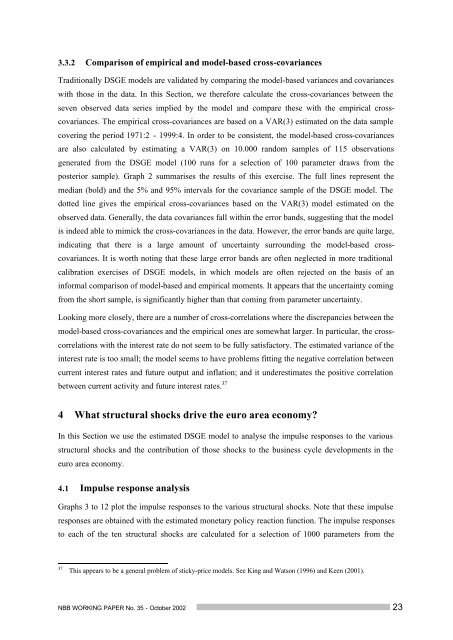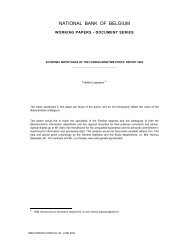An estimated dynamic stochastic general equilibrium model of the ...
An estimated dynamic stochastic general equilibrium model of the ...
An estimated dynamic stochastic general equilibrium model of the ...
Create successful ePaper yourself
Turn your PDF publications into a flip-book with our unique Google optimized e-Paper software.
3.3.2 Comparison <strong>of</strong> empirical and <strong>model</strong>-based cross-covariancesTraditionally DSGE <strong>model</strong>s are validated by comparing <strong>the</strong> <strong>model</strong>-based variances and covarianceswith those in <strong>the</strong> data. In this Section, we <strong>the</strong>refore calculate <strong>the</strong> cross-covariances between <strong>the</strong>seven observed data series implied by <strong>the</strong> <strong>model</strong> and compare <strong>the</strong>se with <strong>the</strong> empirical crosscovariances.The empirical cross-covariances are based on a VAR(3) <strong>estimated</strong> on <strong>the</strong> data samplecovering <strong>the</strong> period 1971:2 - 1999:4. In order to be consistent, <strong>the</strong> <strong>model</strong>-based cross-covariancesare also calculated by estimating a VAR(3) on 10.000 random samples <strong>of</strong> 115 observationsgenerated from <strong>the</strong> DSGE <strong>model</strong> (100 runs for a selection <strong>of</strong> 100 parameter draws from <strong>the</strong>posterior sample). Graph 2 summarises <strong>the</strong> results <strong>of</strong> this exercise. The full lines represent <strong>the</strong>median (bold) and <strong>the</strong> 5% and 95% intervals for <strong>the</strong> covariance sample <strong>of</strong> <strong>the</strong> DSGE <strong>model</strong>. Thedotted line gives <strong>the</strong> empirical cross-covariances based on <strong>the</strong> VAR(3) <strong>model</strong> <strong>estimated</strong> on <strong>the</strong>observed data. Generally, <strong>the</strong> data covariances fall within <strong>the</strong> error bands, suggesting that <strong>the</strong> <strong>model</strong>is indeed able to mimick <strong>the</strong> cross-covariances in <strong>the</strong> data. However, <strong>the</strong> error bands are quite large,indicating that <strong>the</strong>re is a large amount <strong>of</strong> uncertainty surrounding <strong>the</strong> <strong>model</strong>-based crosscovariances.It is worth noting that <strong>the</strong>se large error bands are <strong>of</strong>ten neglected in more traditionalcalibration exercises <strong>of</strong> DSGE <strong>model</strong>s, in which <strong>model</strong>s are <strong>of</strong>ten rejected on <strong>the</strong> basis <strong>of</strong> aninformal comparison <strong>of</strong> <strong>model</strong>-based and empirical moments. It appears that <strong>the</strong> uncertainty comingfrom <strong>the</strong> short sample, is significantly higher than that coming from parameter uncertainty.Looking more closely, <strong>the</strong>re are a number <strong>of</strong> cross-correlations where <strong>the</strong> discrepancies between <strong>the</strong><strong>model</strong>-based cross-covariances and <strong>the</strong> empirical ones are somewhat larger. In particular, <strong>the</strong> crosscorrelationswith <strong>the</strong> interest rate do not seem to be fully satisfactory. The <strong>estimated</strong> variance <strong>of</strong> <strong>the</strong>interest rate is too small; <strong>the</strong> <strong>model</strong> seems to have problems fitting <strong>the</strong> negative correlation betweencurrent interest rates and future output and inflation; and it underestimates <strong>the</strong> positive correlationbetween current activity and future interest rates. 374 What structural shocks drive <strong>the</strong> euro area economy?In this Section we use <strong>the</strong> <strong>estimated</strong> DSGE <strong>model</strong> to analyse <strong>the</strong> impulse responses to <strong>the</strong> variousstructural shocks and <strong>the</strong> contribution <strong>of</strong> those shocks to <strong>the</strong> business cycle developments in <strong>the</strong>euro area economy.4.1 Impulse response analysisGraphs 3 to 12 plot <strong>the</strong> impulse responses to <strong>the</strong> various structural shocks. Note that <strong>the</strong>se impulseresponses are obtained with <strong>the</strong> <strong>estimated</strong> monetary policy reaction function. The impulse responsesto each <strong>of</strong> <strong>the</strong> ten structural shocks are calculated for a selection <strong>of</strong> 1000 parameters from <strong>the</strong>37This appears to be a <strong>general</strong> problem <strong>of</strong> sticky-price <strong>model</strong>s. See King and Watson (1996) and Keen (2001).NBB WORKING PAPER No. 35 - October 2002 23
















